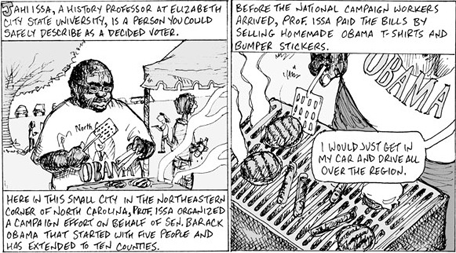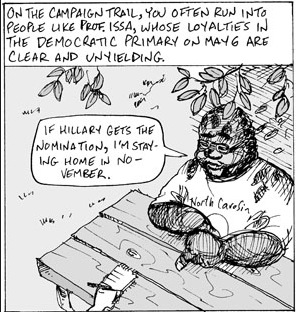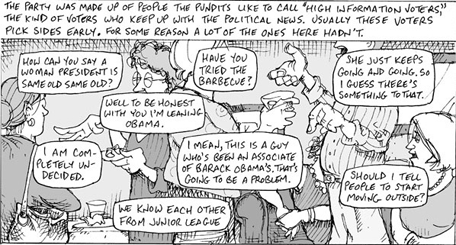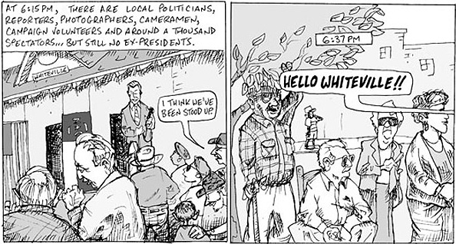Usually, Campbell Robertson, as a thirty-one-year-old theater reporter for The New York Times, writes articles on Broadway and the actors and shows that populate it. But recently the paper dispatched him to North Carolina, where he used the traditional tools of a newspaper journalism—pens and a camera—to untraditional ends. Campbell produced “Primary Pen & Ink,” three twelve-panel reported comic strips illustrating (literally!) the lives, concerns, and decisions of Tarheel voters as Clinton, Obama, and their surrogates crossed the state in anticipation of the May 6 primary. Robertson’s work focused on Asheville, Whiteville, and Raleigh through an engaging and relatable blend of travelogue, ethnography, and pulse-taking. CJR spoke with Robertson about his rules for journalistic cartooning, the challenges of representation in an unfamiliar form, and how the series came to be.
Clint Hendler: What do you like to call these? Cartoons?
Campbell Robertson: I don’t even know myself, frankly. I don’t have any problem calling them comic strips or cartoons. I think the whole graphic novel thing can get a bit pretentious.
CH: Especially when it’s not a novel. You’re doing non-fiction.
CR: Right. I mean, it’s a comic strip, I guess. The only problem is, when I explain to people who might end up in the strip what I’m doing, and I use the words “comic strip,” I don’t want them to get the feeling that the idea is to be funny. Because it’s straight journalism, it’s just in a cartoon format.
CH: How does that conversation usually go?
CR: Well, I introduce myself, and we start talking. I have a camera with me, and I’ll talk to them, take their picture from several different angles. As I’m taking their picture, I’ll explain, look, I’m a staff reporter, but I’m also an artist, and an illustrator, and I’m doing a graphic representation of my reporting on the campaign trail, so I’ll include what you said to me, as well as an illustration of you. And that’s why I’m taking your photograph right now. And generally, they think that’s very odd, and they’re kind of curious. And sometimes, I’ll get their email or their phone, and I’ll call them back to say, again, “I just want to make sure you understand what this is.”
Obviously, the limitation of this form is that you can only portray people who you are sitting right in front of, and you have to portray them as you are talking to you. It’s the same standards as journalism. But you can’t do any work on the phone. And you can’t go back to somebody and put them back in a place where they weren’t. I take that pretty seriously. You have to put them where they were when they said whatever it is what they said.
CH: So if, for example, Professor Issa, from your Raleigh strip, when he’s cooking up some meat on the grill, that’s actually where you were when you were interviewing him?

CR: That’s where I was when I was interviewing him. And then he went to a picnic table, and that’s where he was when he said the thing in the third panel of that strip.

CH: So what about the panel when you are at that event, and you sort of just have all those talk bubbles over a field of people just chatting. Are those just snippets you heard over the course of an evening?

CR: That’s a good question. Those are snippets I heard over the course of an hour or so. I took a lot of pictures of the general party atmosphere and I took one of those photographs and did that sort of picture to give a sense of the party, and I took snippets of the quotes I heard around that same time, careful not to imply that the quotes were being matched with anybody I was picturing.
CH: That visual cue makes a lot of sense: the talk-bubble isn’t going to anyone’s mouth, so therefore it’s not necessarily coming from anyone in the panel. But that’s not something that your average Times reader… that’s not the vernacular. Do they really get what you’re saying, as you’re making this up as you’re going along?
CR: It’s true! But I think people can understand the visual cues quite quickly, even if they’re not huge comic heads. I think the visual language is a little more general than people may realize.
CH: You did actually go to one Bill Clinton event. But I’m not even sure if you draw him, do you?
CR: No. And that was actually on purpose, because I didn’t want people to think of it as caricatures.
CH: Because everyone knows what Bill Clinton looks like.

CR: Yeah, and if you start drawing him, it becomes political cartoons. And I really wanted people to realize that this is not opinion journalism. This, categorically, was not. The reporting of it looked just like any other reporting. And that was the idea. To make it everyday, normal, non-opinion journalism.
CH: Often journalists create portraits from true facts that their interview subjects don’t necessarily feel represent them that well. Just from whatever is selected for the point of the story, quotes that are left out, certain strands of context, whatever. I’m not talking about any fabrication or embroidery. When you are doing comics, non-photorealistic comics, how do you handle people’s appearances? If you draw someone five pounds heavier, or if they see themselves looking five pounds heavier than they think they are…
CR: Honestly, when I’m doing this, I have restrained myself to such a great degree. Because there is sort of a freedom that comes with print that people don’t really think about. I approach this very conservatively. I really try to avoid caricature. You can’t really make jokes. In print you can make funny turns of phrases. But you just don’t have room for that. It’s actually, I think, a very conservative representation, if that makes any sense, even though it is a cartoon.
CH: How did this particular series come about? Did you pitch this, or were you asked to do it?
CR: Four, five years ago, I had mentioned to our internal magazine, Times Talk that I was an illustrator and I did a comic for some internal story, for Times Talk. The Metro display editor at the time, Anne Cronin, saw that and said, “Why don’t you do something for Metro?” So I did a display piece for Metro, as a comic, about a papparazo trailing Madonna. Poynter did something about it at the time. But I then I didn’t really do anything else, because this wasn’t going to be a regular thing.
There’s this editor on the national desk, David Firestone, and we ran into each other one night in the city, like two months ago, and he said, “You should do another one.” And we started talking about the campaign.
You hear a lot of the same things everywhere, in Pennsylvania, Ohio, Texas, North Carolina. “It’s the economy, it’s gas prices.” And even though those are real problems, and people are really hurting, it’s hard to keep that fresh. So I think that was one of the ideas: “Why don’t we try this and come at it from a different angle.” So they sent me down there.
CH: So how long were you on the ground reporting these pieces?
CR: Just shy of two weeks. Basically I’d go and report for two to three days. I’d love to say, “and then I’d draw for three or four hours and I’d be done,” but frankly they take a really long time—fourteen, fifteen hours for a twelve panel strip. So I’d just sort of lock myself in a hotel room, draw it, scan it, put it in Photoshop, send it to the Times and then move on to the next place.
CH: Was there anything that surprised you about the process? What did you learn doing this?
CR: I learned so much. It was always sort of new, because it is so focused on the here-and-now. The rhythms are so different from regular journalism, because you have to be there in the picture, and you have to get as much information into every panel, without overwhelming it with words. So there are a lot of formal challenges, because you want to tell a narrative with an arc, made purely of factual quotes. But at the same time, you just don’t have nearly as much freedom, in a sense, as you do with print, because you can’t just erase and work things differently. You have to think of twelve distinct little stories that come one after the other. So there was a lot of sitting down and thinking about what the whole thing would look like before you could start. Whereas with print, you can just sit down and start writing. There was a lot more pre-thinking, where you sit down and think, “How is this gonna work?” You have to know what every panel will look like before you start the first one.
CH: What’s your cartooning experience?
CR: I did some cartooning in college. I did some stuff for the college paper, the Georgetown Hoya, but very little. I was an English major, and my thesis—and maybe this reflects badly on Georgetown—was a fiction comic book. But I hear they’re still accredited. I did some freelance work, like I illustrated safety manuals for paper plants. I drew this little cat, and he would get his hand caught in the thresher, or whatever, which was great! Just little things here and there.
CH: Do you cartoon anywhere else?
CR: No. No, no. I mean, it’s definitely safe to say I’m a reporter who does some cartooning, rather that a cartoonist who does reporting.
CH: When I saw the first panel, I thought, “You know what? I’m a little worried about this. I think this could maybe come off a little condescending.” And they don’t at all. I feel like I got a chance to look at a lot of these conversations, and to be in a lot of these places. But it just seems like the form would be a bigger pitfall.
CR: You’re exactly right. That was an anxiety of mine, that the form would imply some level of condescension. I’m from a tiny town in the South, in Alabama. So I’m pretty passionate about not being condescending. So that was doubly on my mind. You need to be very, very, very respectful when you report on people who aren’t used to dealing with the media. That’s a pet obsession of mine anyways.
CH: So what do your subjects think about it?
CR: From the four or five people whom I’ve heard from, they got a kick out of it. But I guess the people who didn’t get a kick out of it, they don’t get back to you.
Clint Hendler is the managing editor of Mother Jones, and a former deputy editor of CJR.
